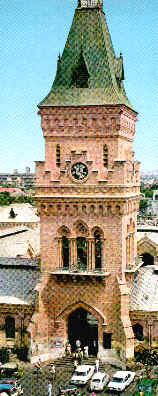|
|
In 1870, Karachi was only sleepy fishing village; now, amid the flurry of modern geometrical-shaped luxury houses in exclusive areas, such as Defence Housing Society. PECHS and KDA Scheme No. 1, and the very contemporary shopping centers in these localities, and other status symbols of the late 20th century, with which the city abounds, one fails to notice number of exquisite Gothic and Moorish works of architecture, built in Karachi, during the days of British rule.
Amusing anecdote is linked with the arrival of British in Karachi. Just after the failure of Great War of Independence, in 1857, when the British influence was beginning to spread to North of the subcontinent, A British ship, "Wellesley", with no more than 300 soldiers aboard under the command of Capt. Preedy, was on vigil, a merely perfunctory one, assumes, near the port of Karachi, by that time busy and prosperous commercial town under the rule of Talpurs. Friendly town, which had little desire to disrupt it simple routine with undignified battle, Karachi arranged that welcoming cannon blast be fired from the fortress at Manora Island. Mistaking it for an act of history, Preedy and his 300 soldiers took over the town, without so much as a drop of blood being shed.
Capt. Richard Burton, destined to become the famous Sir Richard, was put in Charge of Sind by its conqueror, Sir Charles Napier, when the whole of province came completely under the control of British. It was Burton, who shifted the capital of the province from Hyderabad to Karachi. But, the development of the city to bring it on the level with Calcutta or Bombay was hampered until 1937, as Karachi was made an appendage of Bombay Presidency and lost for many years its political importance as metropolis. But, port trade throve and in the course of time, the city was endowed with its many fine, British style private houses, public buildings and churches.
The most prominent of these is "Frere Hall". Striking by reasons of its Venetian-Gothic lines and built as memorial to one-time Commissioner of Karachi, Sir Bartle Frere, often referred to as "Architect of Karachi", because of his great interest in development of Karachi, the hall remains the oldest public building in the city.
A drive around Queen's Road, Bath Island and Clifton areas will reveal many colonial-style residential houses, with their stone and brick structures, red-tiled roofs and oblong stained-glass windows. Another striking example of Gothic architecture and one of the oldest clock-towers on Pakistan, built in 1934 in memory of former governor of Sind, is Mereweather Tower.
The main shopping center of the city was built by British in Civil Lines district. The complex of Bohri Bazaar, Saddar Bazaar and Empress Market was developed about 1869. The area also encompasses Governor's House and Sind and Gymkhana Clubs, structures built in Gothic, Grecian and Roman styles. To the same category belong St. Patrick's Church, other Christian Churches, D.J. Science College and Port Trust Buildings.
Formidable in their majesty are purely Grecian-style, British-Indian structures: Karachi Municipal Corporation, Chamber of Commerce, Bank of India and Chief Court buildings, in red stone, all of them built during 1930s.
And now, Karachi is bustling, bursting international city, industrially and commercially important city of Pakistan.

|
|

